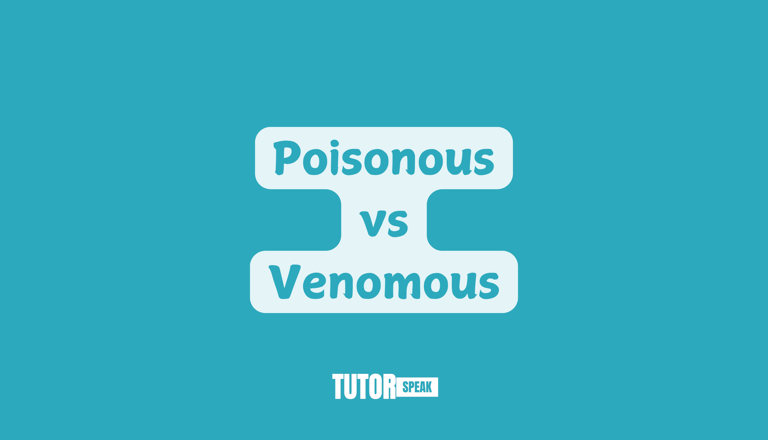Poisonous vs. Venomous: Understanding the Difference
The terms poisonous and venomous are often used interchangeably, but they have distinct meanings in biology and everyday usage. Understanding the difference between these terms is essential, especially if you're a nature enthusiast or want to use precise language.
TutorSpeak
12/15/20242 min read


Poisonous vs. Venomous: Understanding the Difference
The terms poisonous and venomous are often used interchangeably, but they have distinct meanings in biology and everyday usage. Understanding the difference between these terms is essential, especially if you're a nature enthusiast or want to use precise language.
What Does Poisonous Mean?
The term poisonous refers to organisms or substances that are harmful if they are ingested, inhaled, or absorbed through the skin. Poisonous organisms typically release toxins passively, meaning they do not inject the toxin into their victim. Instead, the harmful effects occur when the poison enters the body through indirect contact.
Examples of Poisonous Organisms:
Some species of frogs, such as the poison dart frog, secrete toxins from their skin.
Certain plants like oleander, deadly nightshade, or hemlock are poisonous if consumed.
How Poison Works:
If you eat or touch something poisonous, the toxins affect your body internally. For example, consuming a poisonous mushroom can lead to severe health problems.
What Does Venomous Mean?
The term venomous refers to organisms that actively inject toxins into another organism, typically through specialized body parts like fangs, stingers, or spines. Venom is a tool used for defense or predation.
Examples of Venomous Organisms:
Snakes like the cobra or rattlesnake inject venom through their fangs.
Insects such as bees, wasps, and scorpions sting to deliver venom.
Some sea creatures, like the box jellyfish or stonefish, use venom to protect themselves or capture prey.
How Venom Works:
Venom is delivered directly into the bloodstream or tissues through a bite, sting, or puncture wound. It often contains enzymes and proteins that cause paralysis, pain, or other severe effects.
Key Differences Between Poisonous and Venomous
Method of Delivery:
Poisonous organisms do not inject their toxins; the harm occurs through ingestion, inhalation, or skin contact.
Venomous organisms actively inject their toxins into other creatures.
Purpose:
Poison is usually a defense mechanism to deter predators.
Venom is used both as a weapon for hunting prey and as a defense against predators.
Interaction:
You are harmed by a poisonous organism when you touch or consume it.
You are harmed by a venomous organism when it bites or stings you.
Examples of Misconceptions
"A snake is poisonous."
Incorrect! Snakes, like cobras or vipers, are venomous because they inject toxins through their fangs."A pufferfish is venomous."
Incorrect! A pufferfish is poisonous because its toxin is harmful if eaten, but it doesn’t inject the toxin.
Interesting Fact: Can an Organism Be Both?
Yes, some organisms can be both poisonous and venomous! For example, the blue-ringed octopus is venomous because it injects toxins through its bite, but it is also poisonous if consumed due to toxins in its body tissues.
Exercises
1. True or False
Mark the following statements as true (T) or false (F):
a. Poisonous organisms inject toxins into their prey.
b. The poison dart frog is poisonous because it releases toxins through its skin.
c. Venomous creatures harm you when you ingest them.
d. A rattlesnake is venomous because it injects venom through its fangs.
e. Plants can be venomous.
2. Fill in the Blanks
Complete the sentences with poisonous or venomous:
a. The cobra is a ________ creature that uses its fangs to inject toxins.
b. Eating the leaves of a ________ plant, like oleander, can be deadly.
c. Bees are ________ insects that sting to inject their venom.
d. The brightly colored frog in the rainforest is ________; you shouldn’t touch it!
e. Jellyfish are ________ because they use tentacles to deliver toxins.
3. Choose the Correct Term
Select the appropriate term for the following organisms:
a. Black widow spider: Poisonous or Venomous?
b. Foxglove plant: Poisonous or Venomous?
c. Box jellyfish: Poisonous or Venomous?
d. Monarch butterfly caterpillar: Poisonous or Venomous?
e. Scorpion: Poisonous or Venomous?



